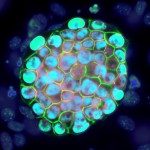Link to Pubmed [PMID] – 9178764
Oncogene 1997 Jun;14(22):2661-70
Transgenic mice carrying either a 1.008 or a 4.225 kb of the mouse c-kit 5′-flanking sequences linked to the oncogenic large T antigen (TAg) region of the simian virus 40 (SV40) genome were generated to test if the c-kit promoter could be used to develop useful mouse models. Both constructs promote tumourigenesis in the pituitary and the thyroid with high efficiency. The cell types from which each of these tumours derives were identified. Tumours of the pituitary derive from alpha-MSH-expressing cells located in the intermediate lobe. Transformed cells of the thyroid were calcitonin-positive, implying that the tumours derive from C cells or their precursors. Chromogranin A and neuron-specific enolase, general neuroendocrine cell markers, were expressed in both tumour types. Furthermore a variety of tumours appeared in the transgenic mice. Several of them stained positively for chromogranin A and/or neuron-specific enolase. This suggests a previously unsuspected tissue-specificity of the c-kit 5′ flanking sequences for neuroendocrine cells. The Kit-TAg transgenic mouse lines may represent a valuable model for the study of the development and the biology of neuroendocrine tumours.

